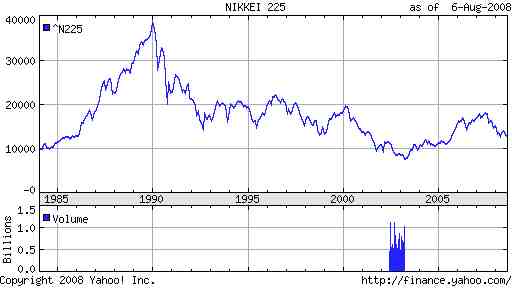As we discussed in my September 2007 column, the damage from a financial credit crisis can be devastating. The analogy I drew then was with the Japanese economy in the 1990s. Let’s take a look at what happened to their stock market:
Japan’s financial credit crisis began in 1990 when their real-estate market collapsed after a decade-long bubble. Their primary stock market index, the Nikkei 225, plummeted from about 40,000 to 15,900 in two years. And then it went sideways for another ten years before plunging to a new low of 7900 in 2003. The critical point is that the Japanese investor who invested at the peak is down 67 percent after almost two decades. So much for the triumph of the long-term investor.
We cannot say that the U.S. will repeat this dismal experience because each crisis has its own particular dynamic. We simply don’t know the answer to the key questions. How much bad debt will need to be written off? What policies will the Federal Reserve and the new incoming president implement? At what point will unemployment peak?
On the other hand, we can’t rule out worse scenarios either. Note that Japan’s crisis happened while the rest of the world had strong economic growth. It’s hard to imagine, but Japan would have had an even rougher time if the global economy hadn’t buoyed them up. The bad news is that if we look at today’s credit crisis, there are signs that the slowdown is global in scope. Shanghai’s stock market is already down more than fifty percent from its peak last October while India’s Bombay Sensex index is down twenty-five percent from January. If we fall, there will be no one to catch us.
What’s the bottom line?
